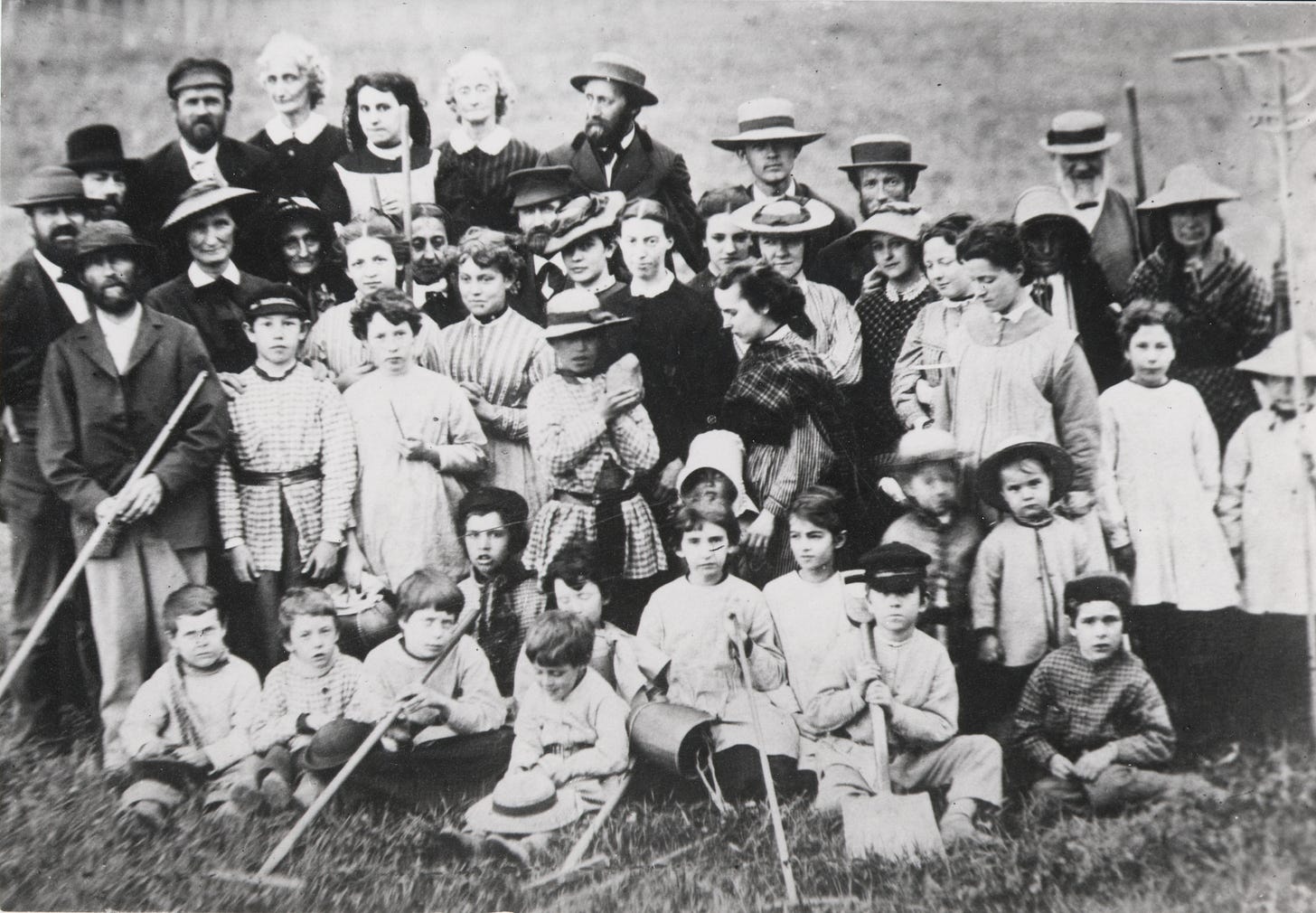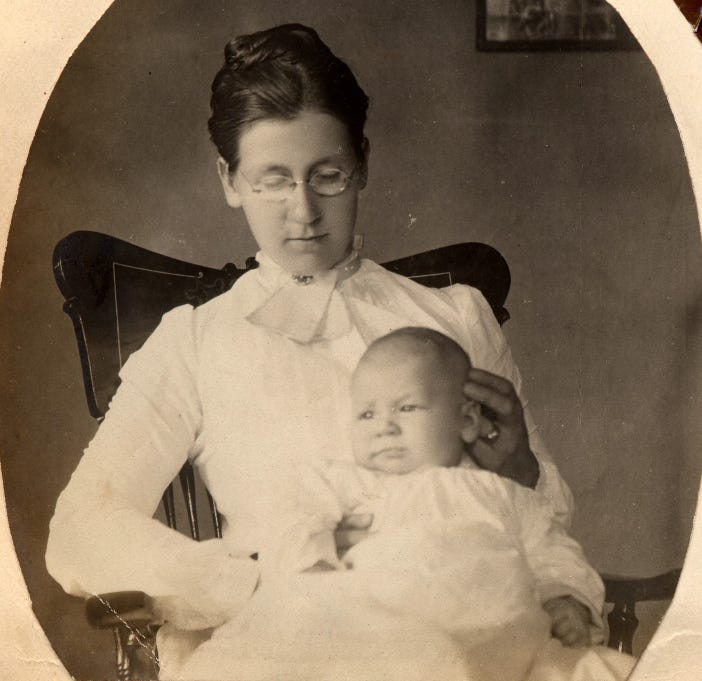Oneida: The Victorian Free Love Commune that Changed the US
The 1850s commune spawned business practices and businesses that exists to this day.
This post explores the business impact of the Oneida Community. A follow-up will explore the political impact that has profound ramifications to current events.
Businesspeople are expected to look and act a certain way. There’s a not-so-subtle amount of racism, sexism, and ageism in this belief which research shows is oftentimes a lousy predictor of business success. My research includes countless innovators who built enormous businesses or changed the world but looked and behaved in a way most investors would shun. Conversely, Charles Ponzi and Bernie Madoff looked and acted perfectly. Today, we explore the utopian communist enclave, Oneida, who built a business that lasted ages and a political movement that continues to reverberate.
“Property and persons are held in common. No one of himself owns anything. They commenced poor, now they are rich. The location is the most beautiful in the land. It embraces over 500 acres in the choice Oneida Valley. The principal residence is brick, three stories high, and as extensive, as neat, and as elegant as are buildings erected by the State for benevolent purposes. The grounds are laid out by a scientific, rural architect. There are evergreens, hedges, clumps of trees, shaded winding walks, bowers, summer-houses, and borders and gardens of flowers. The most refined taste is gratified. Last summer they had 6000 visitors.”
— New York Tribune, May 1, 1867
In 1848, the same year Marx and Engels published the Communist Manifesto, a group of men and women formed a communal utopian community in upstate New York. Led by John Humphrey Noyes, the original group of 87 members quickly grew in size, wealth, and influence.
Educated at Dartmouth and Yale in law and theology, Noyes wasn’t an economic outcast who decided to reject capitalism; his father was a Congressman and his cousin President Rutherford B. Hayes. Noyes, however, embraced a radical theological underpinning against individual ownership. Specifically, Noyes practiced and taught “mutual criticism,” “complex marriage,” and “male continence” were key to a good and godly life. Noyes joined a theologically like-minded group called “perfectionists” and became their leader.
Mutual criticism is the easiest concept to understand and remains a management principle to this day. It’s essentially an ongoing “360-degree review” with the notion that in professional or personal matters transparency and honesty are vital to individual and collective well-being and growth. A century before Ray Dalio was born, Oneida practiced the radical truth and radical transparency principles he’d institutionalize at Bridgewater.
Complex marriage is nonmonogamy where every member is married to every member of the opposite sex. Despite his own marriage to Harriet Holton, whose grandfather served in Congress, Noyes didn’t believe that one-to-one relationships were healthy or beneficial. He was not a polygamist like Joseph Smith, the founder of the Mormon Church. Rather, Noyes thought and taught that men and women should interact with one another on a non-exclusive basis at work, home, and in bed. Holton, his wife, shared his beliefs.
Male continence was used as birth control. With no other known birth control method available, Noyes believed men should not finish which, in his theory, prevented pregnancies that bogged down and limited women’s choices in life.
Others at the time weren’t especially enthusiastic about his ideas, especially regarding free love, and in 1848 Noyes was forced by “a mob” to flee Connecticut to the town of Oneida, in rural upstate New York. During the early and mid-1800s, upstate New York was to radical religious sects as Silicon Valley is these days to tech companies.
It’s unclear if Noyes was aware of Marx’s work or if his drive towards communal living was out of economic necessity that dovetailed with his theological teaching. In any event, the members of his commune were so poor, at first, that they slept on the floor in a barn. Most of the early adopters, besides those who’d moved with Noyes when they fled, were equally poor New England farmers who had little to lose when joining the quirky cultish religious group.
As Oneida formed, all rights to exclusivity in all matters of life were deeded to the community. Nobody owned anything individually and, during an era when sex wasn’t openly discussed, the community embraced Noyes’ teachings and disavowed monogamistic relationships. “All men and women were expected to have sexual relations and did,” wrote Noyes, explaining the arrangement bluntly.
Many of Oneida’s practices were far ahead of their time. Women enjoyed vastly more rights than other women of the era, including an expectation to education and work in similar jobs to men, the right to accept or reject sexual partners and to enjoy sex, and even a vastly more comfortable wardrobe than other women of the time. Just as substantively, there was no expectation that women should bear or raise children. Pregnancies were carefully planed and children raised by the community.
While the people of Oneida personally believed in communal living, the collective as a whole eventually did exceptionally well in business. Initially, the commune started farming which went about as poorly as one would expect for a group of New England intellectuals. Soon, they moved into industry opening a sawmill, blacksmith shop, and a manufacturing facility focused on animal traps. The commune ventured into furniture making, travel bags, satchels, silk production, preserved fruits, and even some type of ferry service.
Their ventures thrived. By January 1857, the commune had cash and inventory valued at just over $67,000, an enormous sum at that time. Throughout, they used their wealth to expand. The original farm at Oneida was 40 acres but, by 1874, they purchased another 654-acre farm nearby, and soon after, a 240-acre farm at Wallingford. The free-love communists were kick butt capitalists.
Thanks to carefully selecting members, demographics at Oneida were well balanced. By February 1874, 131 of the commune members were men and 152 were women. Of those, 219 were adults and 64 were children. About half the adults, 104, were over 45 years old. Members came from eclectic backgrounds; there were doctors, teachers, and lawyers but also farmers and mechanics. As word of their wealth and lifestyle spread, the commune received countless applications and rejected most of them.
The commune employed non-member locals as laborers in the workplace and, as their wealth grew, as servants to cook and clean for the collective. Locals reportedly loved their commune employers who paid well, extended far better working conditions, and built workers privately-owned homes on nearby farms. “The members do not now work very hard … but they are steadily industrious. Mere drudgery they nowadays put upon their hired people” explains an eyewitness historian.
Their free-love principles were straightforward. Anybody could have sex with anybody else as long as both consented. Unlike the rigid expectations for women of the time, any member was free to make advances and reject the advances of any other. The emotional attachment of two people in a monogamous relationship was termed “selfish love” which they sought to break down “rigorously.” This was apparently a recurring problem, especially for young people.
“Male continence” seems to have worked and the commune was able to control the number of children to a “normal” number (their word) based on the commune’s adult population. Children were raised by a committee of men and women; a woman’s individual obligation to her child ended after the child weaned. Children had their own house. They ate in the same communal dining room with the adults but sat together at their own tables.
Some children were sent to college while others learned trades. College was gender restricted so male children attended Yale where they became physicians, engineers, chemists, and architects. Promising females were sent to art schools. Other children learned various trades without regard to gender; for example, girls learned to be machinists and boys learned to weave.
The collective practiced a form of eugenics, purposefully coupling men and women they thought would produce more religious babies. They referred to the practice as “stirpiculture” and the subsequent children as “stirpicults.”
Daily and longer weekly meetings involved “mutual criticism,” where the person being criticized sat silently and listened. A witness describes the process: “This system takes the place of backbiting in ordinary society, and is regarded as one of the greatest means of improvement and fellowship… This ordinance is far from agreeable to those who egotism and vanity are stronger than their love of truth. It is an ordeal which reveals insincerity and selfishness; but it also often takes the form of commendation, and reveals hidden virtues as well as secret faults. It is always acceptable to those who wish to see themselves as others see them.”
One session describes group criticism of a young manager who is especially skilled at work but has developed a haughty attitude. His peers explain their perception of him and how his behavior makes them feel. The session is in no way mean-spirited but, rather, geared towards explaining that a better attitude on his part would meet with a better attitude from others so everybody would be happier and emotionally healthier. It sounds like an early form of group therapy rather than an unproductive airing of general grievances.
Books and all business matters were entirely open and business operations are made by consensus. If any member objects, the commune discusses their concern until everybody agrees. The commune had an enormous number of administrative committees and women were equal to men in positions of power.
Tensions continued to flare as Noyes aged and attempted to pass control of the commune to his son, who was largely indifferent to the teachings of Noyes, rather than a different member the community preferred. Furthermore, it is suggested many members, led by James W. Towner, frowned upon Noyes’ control and initiated an internal revolt.
In June 1879, Noyes was accused of statutory rape and fled to Canada where the commune ran a factory. Already facing internal conflict, Oneida’s disintegration accelerated in the late 1870s as outsiders revolted against complex marriage. Noyes advised the commune to abandon complex marriage and the members coupled into monogamist relationships. The community officially dissolved in 1881, the business converted into a corporation with shared issued to members. Noyes died five years later, in 1886. His body was returned to the commune and buried in the communal cemetery.
After the dissolution, Towner and his followers moved to California with their share of wealth. They purchased enormous tracts of land. The Governor of California recognized their political power and rewarded them by carving a piece of land, naming it Orange County, and appointing Towner the judge. Oneidian Townerites still practiced free love, egalitarianism, and communism though they’d learned their lesson about upsetting the locals and kept the practice more discreet.
The locals were wary. “It is difficult to figure this thing out — whether it is another ‘Oneida Community’ business or a ‘Mormon outfit.’” wrote the Santa Ana Weekly Standard on June 9, 1882. “At any rate it will be a good idea for parents to keep their eyes on their daughters and husbands on weak wives. . .” (ellipses included in the original).
The Townerites were influential in establishing a moral openness that persists and permeates California thinking to this day. Their influence on the early Republican Party, which they embraced as Civil War veterans firmly committed to freedom and abolition, cannot be overstated.
Oneida’s most successful business, Oneida tableware, still exists. Over the past decade or so, US operations were largely shuttered and outsourced, after 150 years, as private equity firms did that voodoo that they do so well. They eventually bankrupted the business. Twice. Today, Oneida is owned by The Oneida Group.
If you enjoyed this newsletter, please consider sharing it and subscribing for more.










Wonderfully written and very informative.